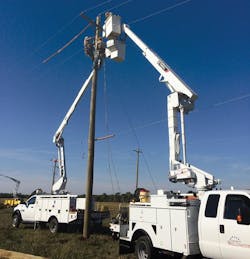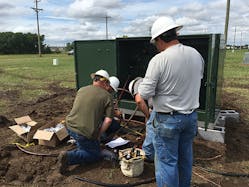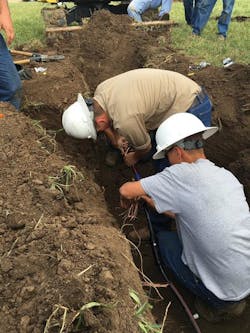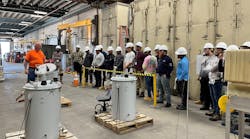Fifteen years ago, Kansas Municipal Utilities (KMU) had a vision to create a training center to prepare the next generation of field workers. In November, KMU’s dream became a reality as it cut the ribbon on its new $3.2 million facility.
KMU, an association of municipally owned and operated utilities in Kansas, broke ground on the 20,000-sq-ft building in October 2015. The association opened the new training center to meet the needs of its members who were facing the challenges of an aging field workforce.
Through a survey, KMU discovered that many energy companies were facing labor shortages across the board from linemen to field managers to engineers. Also, they expected the problem to worsen as waves of workers were planning to retire in the next three to five years.
To support public utilities in the state of Kansas, KMU looked for a way to short-circuit the learning curve so utilities could swiftly prepare new hires to work as effective front-line employees. As such, KMU acquired 35 acres of land in McPherson, Kansas, and began forging ahead on its mission to train field workers.
Offering Indoor Training
Over the last four years, KMU has provided outdoor workshops for overhead and underground electric distribution and gas operations when the weather conditions are favorable. In the event of rain or snow, however, KMU had to cancel the training sessions and workshops.
With its new training center, KMU will be able to provide training to its members year-round, even during the scalding summers and blistering winters. That way, utilities don’t have to send the bulk of their workforce to KMU for training during their busy construction season.
Under the roof of the new training center, KMU can provide a variety of workshops and training programs. In addition to its 300-seat auditorium, the facility also offers an 8,000-sq-ft shop area, where it can handle the majority of the lab work.
To allow journeymen linemen and apprentices to practice climbing, KMU also set four wood poles inside the building. Along with its pole climbing clinics, KMU also offers hands-on training on metering and transformer connections.
Outside the training facility on the grounds, KMU’s staff members and linemen from across the state of Kansas helped to erect 50 wood poles for hands-on workshops. To make the distribution system as realistic as possible, KMU integrated three-phase pad-mounts, junction boxes, eight single-phase pad mounts, reclosers and switches. Both the single- and three-phase are looped, along with two of the overhead circuits for real-world training. In addition, linemen can train on 10 short poles. As a result, the instructors can more easily coach the students as they practice tying insulators and conductors or building transformer banks.
Working Together
The new training center serves 118 public power utilities that serve a median of 850 meters. Back in 1928, KMU was founded to meet the needs of these public power utilities across the state of Kansas. Membership for the non-profit association is open to any public entity, city, county or public subsidiary that owns or operates an electric, gas, water and/or wastewater utility. The members range in size from a small public power company that serves 50 meters up to the Kansas City Board of Public Utilities, which manages about 65,000 meters.
By working together, the utilities can provide a higher level of training than they can do individually. Many of the members of KMU are small in scope, and as such, they don’t have the ability to provide a comprehensive training program or build a facility of their own. Because every utility needs to have a safe, qualified workforce, KMU helps Kansas public power entities to meet this objective.
The project was completely funded by membership dues, which allows KMU to produce a higher number of events at a lower price point. Going forward, many of the new hands-on classes tie into KMU’s existing curriculum, which trains the next generation of workers — from lineworker apprentices to gas workers to water department employees.
Training Apprentices
Since 2004, KMU has managed a lineworker apprenticeship program, which is registered by the state of Kansas. In 2014, KMU updated its program to ensure its apprentices successfully complete the required number of hours and also demonstrate competency in certain skills. For example, apprentices must be able to show how to care for and select proper tools, safely climb poles or build structures. Over time, the members have worked with KMU to dictate which skills their apprentices need in order to safely and efficiently work on their systems when they top out as journeymen.
Since the beginning of the apprenticeship program, about half of the members have sent their workers to KMU for its apprenticeship program. Currently, KMU has 60 apprentices in its program, and 45 of its member utilities are using the program to train their workforce. As a result, KMU has built extensive infrastructure on its grounds for overhead distribution, underground distribution, water and wastewater systems, and natural gas systems. In addition, KMU recently installed a new substation transformer, and in the future, linemen will build 69-kV and 115-kV transmission lines to complement the distribution infrastructure on the grounds.
Gaining Hands-on Experience
In addition to apprenticeship programs, KMU also offers specialized workshops that allow public utility field workers to get hands-on training in a controlled environment. As a result, the training mitigates some of the hazards inherent in utility work, and it allows the field workers to make mistakes in a safe environment.
For example, if a lineman accidentally makes contact on KMU’s de-energized line, then the instructors can step back and discuss what went wrong and what they can do to make sure it doesn’t happen again. If that same accident happened in the real world, however, the same discussion would happen after the lineman wound up in the hospital or after his funeral.
Because safety is an integral part of all utility work, the new training center helps the students learn through hands-on instruction. While they can pick up on key knowledge through sitting in class and reading books, the real rubber meets the road when they are actively participating in hands-on learning. To this end, KMU’s training is typically about 80% in the field and 20% in the classroom.
For example, if KMU offers a workshop on transformer theory and connections, then the linemen can get hands-on experience immediately after they receive classroom instruction to connect their learning to actual work. Using the transformer boards in the lab, they can make connections and figure out loads on a wire delta system. Next, they can work on actual transformers on the short poles inside of the training facility.
Staying Safe
On the KMU grounds, the 12-kV distribution system is de-energized, but the linemen perform a lot of simulated hot work. As such, when they are working out on the system, they are working as if it’s energized. During the workshops and apprenticeship programs, the students abide by the mantra, “Work it hot or ground it dead.”
As such, they use hot sticks and take into consideration the different approach distances. In addition, the linemen dress the same way they do for a work day back home by wearing rubber gloves, hard hats, safety glasses and arc-rated clothing. In some cases, if they are being trained on working on high-voltage enclosures, they also wear an arc flash suit, shield and balaclava.
In addition, the students also wear full fall protection. Since 2004, some of KMU’s associate members have provided fall-restraint devices. Even before OSHA began requiring full fall protection, KMU has required anyone who is climbing the poles to wear fall protection. Three years ago, KMU also invited vendors to come out to the grounds to demonstrate different products and allow the students to climb using a variety of different harnesses.
Practicing Underground Skills
During the workshops, KMU is able to bring different linemen together from various parts of the state of Kansas to build a section of line, change out crossarms or maintain poles. At the start of the three-day workshops, the instructor gives the students a real-world scenario and assigns one journeyman to be the crew leader. As such, the linemen have the opportunity to not only hone their skills but also to cut their teeth as crew leaders.
Then during the course of the training session, the linemen must work together to complete tasks and fulfill objectives. For example, during a recent overhead workshop that had about 70 students, the linemen participated in a class on transformer theory and connection, rigging and knots, and building a new circuit. The linemen also changed out crossarms on a double dead-end turn pole.
For the underground training, the workers practiced hands-on skills such as locating faults on direct-buried cable and then digging it up and splicing the cable. In addition, the students practiced the switching procedure for underground systems and learned about proper isolating, testing and grounding, and how to identify, prepare and terminate cable.
At the new training center, KMU now can offer year-round hands-on and classroom instruction in its training yard and inside the facility. As a result, KMU can help public utilities train the next generation of line workers and help confront the impending labor shortage head on.
Rick Aguilar is the director of job training and safety for Kansas Municipal Utilities in McPherson, Kansas. He has been with KMU since 2008. During his 18-year career, he has worked in various craft, training, safety and leadership positions in the telecommunications and utility industries.






